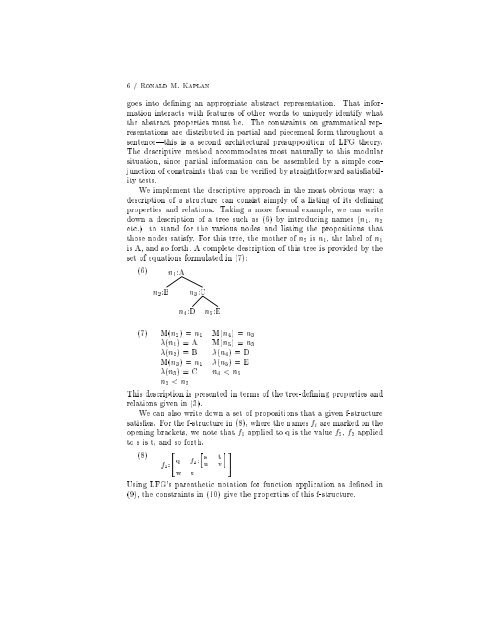The Formal Architecture of Lexical-Functional Grammar
The Formal Architecture of Lexical-Functional Grammar
The Formal Architecture of Lexical-Functional Grammar
Create successful ePaper yourself
Turn your PDF publications into a flip-book with our unique Google optimized e-Paper software.
6 /Ronald M. Kaplan<br />
goes into de ning an appropriate abstract representation. That information<br />
interacts with features <strong>of</strong> other words to uniquely identify what<br />
the abstract properties must be. <strong>The</strong> constraints on grammatical representations<br />
are distributed in partial and piecemeal form throughout a<br />
sentence|this is a second architectural presupposition <strong>of</strong> LFG theory.<br />
<strong>The</strong> descriptive method accommodates most naturally to this modular<br />
situation, since partial information can be assembled by a simple conjunction<br />
<strong>of</strong> constraints that can be veri ed by straightforward satis ability<br />
tests.<br />
We implement the descriptive approach in the most obvious way: a<br />
description <strong>of</strong> a structure can consist simply <strong>of</strong> a listing <strong>of</strong> its de ning<br />
properties and relations. Taking a more formal example, we can write<br />
down a description <strong>of</strong> a tree such as(6)byintroducing names (n1, n2<br />
etc.) to stand for the various nodes and listing the propositions that<br />
those nodes satisfy. For this tree, the mother <strong>of</strong> n2 is n1, the label <strong>of</strong> n1<br />
is A, and so forth. A complete description <strong>of</strong> this tree is provided by the<br />
set <strong>of</strong> equations formulated in (7):<br />
(6) n1:A<br />
n2:B n3:C<br />
n4:D n5:E<br />
(7) M(n2) =n1 M(n4) =n3<br />
(n1) =A M(n5) =n3<br />
(n2) =B (n4) =D<br />
M(n3) =n1 (n5) =E<br />
(n3) =C n4

















